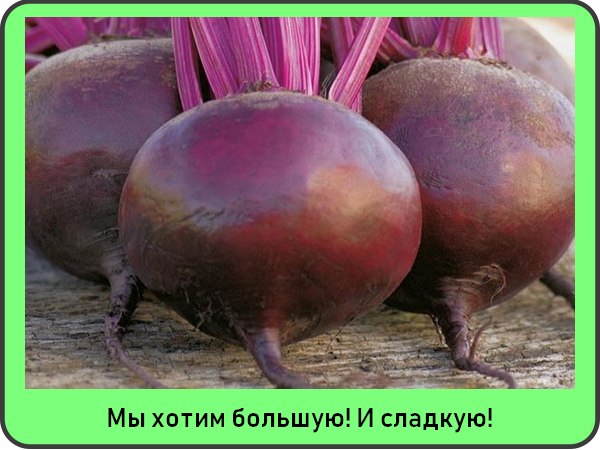Beets grow small and not sweet if they grow in soils that do not suit them. And she loves humus-rich, air- and moisture-permeable soils. Therefore, it is better to place it in areas where organic matter was added last year.
We planted large beets, but they grew small
Root crops grow small when sowing is too dense.
Beetroot seeds, although not small, are multi-sprouting; several root crops can grow from one seed. Therefore, even the most diligent summer residents always end up with thickened crops.
Conclusion: to prevent beets from becoming small, they must not only be planted rarely, but after the emergence of seedlings, be sure to pull out the excess shoots. There should be at least 15-20 cm between plants in a row.
Beetroot tolerates a temporary lack of moisture better than other root crops, and yet you should not test its strength: a gap in watering, especially during the period of root crop growth, leads to the fact that they do not reach the standards of the variety and turn out small.
Its development is also hampered by too frequent watering: the soil becomes compacted, the roots begin to lack air.
How to grow sweet beets
| Most of all, timely fertilizing contributes to improving the taste and the appearance of sweetness in root crops. |
|
The first time beets are fed at the stage of 3-4 true leaves (1.5 cups of mullein infusion, a tablespoon of complex fertilizer per bucket of water, consumption per sq. m). Separately, you can fertilize with a solution of boric acid (1 g), table salt (a teaspoon per bucket of water). As a second feeding, which is carried out three weeks after the first, before loosening and watering, sprinkle the rows with wood ash or give the beets potassium magnesium (a teaspoon per bucket of water). |
Advice from experienced gardeners:
During the growing season, beets are fed “for sweetness” with a solution of table salt: tbsp. spoon on a bucket of water.
As you can see, it's all about agricultural technology. If beets are properly cared for, they will be both large and sweet.




 (3 ratings, average: 3,67 out of 5)
(3 ratings, average: 3,67 out of 5) CUCUMBERS NEVER GET SICK, I'VE BEEN USING ONLY THIS FOR 40 YEARS! I SHARE A SECRET WITH YOU, CUCUMBERS ARE LIKE THE PICTURE!
CUCUMBERS NEVER GET SICK, I'VE BEEN USING ONLY THIS FOR 40 YEARS! I SHARE A SECRET WITH YOU, CUCUMBERS ARE LIKE THE PICTURE! You can dig a bucket of potatoes from each bush. Do you think these are fairy tales? Watch the video
You can dig a bucket of potatoes from each bush. Do you think these are fairy tales? Watch the video
 How our fellow gardeners work in Korea. There is a lot to learn and just fun to watch.
How our fellow gardeners work in Korea. There is a lot to learn and just fun to watch. Eye trainer. The author claims that with daily viewing, vision is restored. They don't charge money for views.
Eye trainer. The author claims that with daily viewing, vision is restored. They don't charge money for views. A 3-ingredient cake recipe in 30 minutes is better than Napoleon. Simple and very tasty.
A 3-ingredient cake recipe in 30 minutes is better than Napoleon. Simple and very tasty. Therapeutic exercises for cervical osteochondrosis. A complete set of exercises.
Therapeutic exercises for cervical osteochondrosis. A complete set of exercises. Which indoor plants match your zodiac sign?
Which indoor plants match your zodiac sign? What about them? Excursion to German dachas.
What about them? Excursion to German dachas.